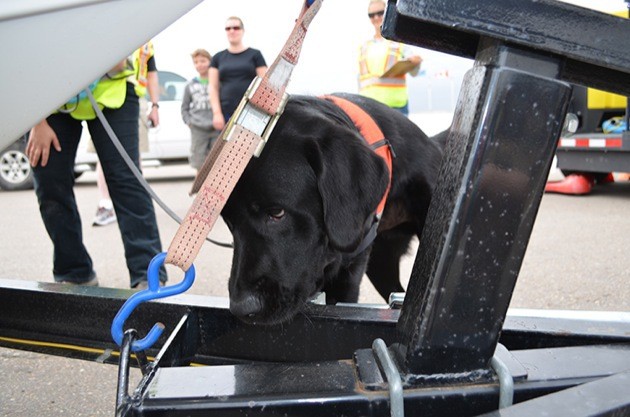Dogs, drones and DNA testing are emerging as new tools to detect invasive species and keep them from becoming entrenched in B.C.
The new tactics were described by experts Tuesday at a conference of the Invasive Species Council of B.C. in Richmond.
Trained sniffer dogs have proven much more effective than human teams, particularly at night, in detecting tiny invasive zebra mussels that can cling to boats and then infest new lakes, according to Cindy Sawchuk, who heads Alberta’s Conservation K9 program that helps inspect water craft arriving in that province from the east and south.
Most of the 11 mussel-infested boats intercepted last summer entering Alberta from other jurisdictions were ultimately destined for B.C. lakes.
Sawchuk’s superiors had dismissed her proposal for dogs as useful only for public relations, so she designed a trial in 2014 to test them.
“The dogs were 100 per cent accurate in detecting the mussel-fouled boats and our humans came in at 75 per cent,” Sawchuk told delegates. “The dogs were also much quicker at detecting it. They averaged 2.3 minutes. And that included their play time for their reward.”
Speedier inspections also mean less resistance from boat owners, some of whom had told Sawchuk they’d taken to entering the province in the dead of night to avoid inconvenience.
The three highly trained dogs – Hilo, Seuss and Diesel – cost $25,000 each but Sawchuk says they’re cheap compared to an estimated $75 million a year Alberta estimates it would spend clearing clogged pipes, canals and water intakes if the mussels arrive.
Delegates also heard from Fisheries and Oceans Canada scientist Davon Callander who is using DNA testing of water samples in the B.C. Interior to quickly determine if a given lake has a particular invasive fish species.

Releasing a drone in a patch of invasive Reed canary grass in the Creston Valley Wildlife Management Reserve..
Drones are being used near Creston to aerially map infestations of yellow flag iris, an invasive plant, in hard-to-reach wetland locations.
Catherine Tarasoff, a researcher with Thompson Rivers University, hopes the rapidly evolving technology will soon allow scientists to program drones to fly autonomously at high speed, scanning large areas and stopping only to alert their operators when a suspect patch of vegetation matches target images.
Technology may be helping thwart alien invaders.
But Gail Wallin, executive director of the Invasive Species Council of B.C., says the best prevention rests in better choices by people, whose decisions in the past ushered in many of the species now disrupting ecosystems in B.C.
Japanese knotweed – which is nearly impossible to eradicate and can punch through concrete – menaces roads, bridges and building foundations across Metro Vancouver and was first introduced as a garden plant.
So was giant hog weed, another invasive landscaping plant but one that poses such a serious human health risk that there are specific WorkSafeBC rules for dealing with it.
“It’s a great big tall 10 to 15 foot plant that’s got a hollow stock and it’s got a sap inside that causes your skin to be photosensitive, so when you get sun on it you get a second degree burn,” Wallin said.
“Ten years ago people were proud that they had this exotic plant. Well now, you get it in park lands or around marsh areas and you wonder why did we ever plant this stuff in the first place. Because now we’ve got to hire teams in haz mat suits to remove it.”
Flowering rush is a new invasive plant that has been detected in three areas in B.C., including Whistler and the Hatzic area of the Fraser Valley, triggering an emergency response by the province to contain it. The plant grows underwater in lakes and is very difficult to remove because the tiniest portion of the root left behind just regenerates more.
Problematic invasive critters in the Lower Mainland include red-eared slider turtles and American bullfrogs, as well as European fire ants, whose hostile attacks can render backyards almost unusable.
The fire ants are thought to have often been spread when soil from construction sites was trucked from one place to another in the Lower Mainland.
Feral pigs are running amok in some parts of southwestern B.C., but are a more significant problem in the Interior.
The release of pets into the wild – rabbits, goldfish, koi and even the bizarre snakehead fish found in a Burnaby pond in 2012 – are yet more examples of where people could do better, Wallin said.
What species haven’t yet made a beachhead that Wallin would like to keep out?
She names rusty crayfish, which has arrived in Oregon from the east coast, likely as live fishing bait that escaped and thrived.
“It’s a fairly aggressive crayfish and it can come in and overtake some of the native species and clams that are here.”
Another is the European green crab, which has arrived on the west side of Vancouver Island, but has not yet reached Georgia Strait and Howe Sound.
B.C.’s costs of dealing with invasive plants alone is estimated to hit $139 million a year by 2020, twice as much as in 2008.
